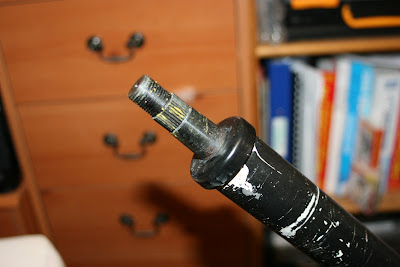Ok, so that's the intro over. Here's what you are going to need to know if you want to get a buggy road legal in the UK. Bear in mind that this info is to the
best of my current knowledge and if you have any extra experience, please let me know or post a comment. There is very likely to be stuff I've not covered here.
Firstly, is your buggy/cart over 10 years old? If so, you have a much much much easier job to do. If not, then you are going to need to put in loads of extras and get it through an MSVA test. Here's the rough roadmap you need in either case:-
If over 10 years old:-
- You need to get it through an MOT according to the regs that applied the year of manufacture. To do this, you'll need a receipt showing when it was bought as proof, and a copy of "The Road Vehicles (Cosntruction and Use) Regulations 1986" as a guide. This is about as easy to read as Dostoyevsky, so here are the basics that apply to golf carts: firstly, you'll need some kind of independant handbrake mechanism that works on either to front or rear wheels. Secondly, you'll need to sort out basic lights and possibly seatbelts (I'm still researching this). Finally, you'll need road legal tyres.
- Assuming you get throught the MOT, you can then take the certificate down to the DVLA together with a V55/5 form, and get a VIN (Vehicle Identifiation Number) number issued.
- You then can go and get a Q plate
- You can then get taxed and insured and you're on your way
If under 10 years old:-
- You'll need to get hold of the MSVA regulations test handbook. It's very well laid out and v easy to read. Ask me if you want to borrow a copy. Then you'll need to go through every item exhaustively and make sure your buggy complies. This is going to mean a *lot* of work depending on the model of your buggy. Loosely, these are the main big problems to overcome: firstly you need brakes on both front and back wheels, plus an independent handbrake system. There are ways of doing this that I've researched, but none look easy or cheap. Secondly, you need a full complement of lights that conform to the SVA regs - not simple but not impossible either. Thirdly, you'll need to sort 3 point seatbelts and this can be problematic on some models, although there are solutions. Finally, you'll need all the basic instruments such as horns, speedos etc. that a modern car should have.
- Once you've done all this right, book a MSVA test at a DVLA testing centre (there are quite a few scattered around the UK), take the buggy there on a trailer. Hopefully you'll pass!
- You are then issued with a VIN, which you can use to get a reg plate, tax, insurance and then on the road!
So that's the roadmap sorted.... now to plan the work......
 Me in the car park outside our house, on the bug after having driven 5 miles from it's garage. Boy was it cold! Battery meter showed capacity at 85%, which sounds way too good, but these are pretty new T-105s so hopefully this is a good sign for future longer drives.
Me in the car park outside our house, on the bug after having driven 5 miles from it's garage. Boy was it cold! Battery meter showed capacity at 85%, which sounds way too good, but these are pretty new T-105s so hopefully this is a good sign for future longer drives. This is a nice side view shot. You can see the new wheels. I've used trailer style wheels to comply with the MOT requirements... I don't think they look as good as the cool buggy wheels you can get in the states, but these are at least affordable and tyres are cheap.
This is a nice side view shot. You can see the new wheels. I've used trailer style wheels to comply with the MOT requirements... I don't think they look as good as the cool buggy wheels you can get in the states, but these are at least affordable and tyres are cheap.


















